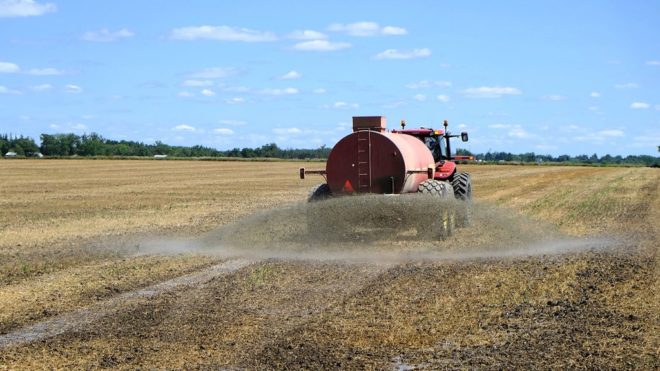The management of manure has always been an integral part of a livestock farm in order to provide a clean-living environment for the livestock. Manure field applications are arguably the most important part of manure management and, depending on who you ask, are a big reason for that fresh country air smell that everyone knows and loves!
Manure, as a fertilizer, is a valuable source of nutrients including nitrogen (N), phosphorus (P), potassium (K), and many micronutrients. Manure can provide numerous benefits, including improved soil structure, aeration, nutrient availability, and it can limit soil erosion and nutrient runoff. The carbon aspect of manure is the main driving force for these benefits and is also what sets it apart from synthetic fertilizers. However, not all manure is created equally, and multiple factors can affect the nutrient content of manure.
What Factors Affect the Nutrient Content in Manure?
Many factors affect the nutrient content of manure including livestock type, stage of growth, diet, bedding, storage, and duration of storage. Livestock type plays a large role in manure nutrient content. For example, most P in feed is in the form of phytate. Pigs and chickens cannot digest phytate which leads to a large amount of P in the manure. Additives are available to help with digesting the feed in the animals gut. Livestock stage of growth can affect the nutrient content because of the differences in feed rations. However, regardless of their stage of growth, livestock will excrete 50 to 90% of the nutrients fed.
Bedding can have more of an effect on nutrient availability, especially when dealing with solids. This is because of the carbon rich bedding material, like straw, that raises the C:N ratio and limits N availability. Manure storage systems have a large impact on N content depending on the surface area exposed to the atmosphere, which could promote N volatilization, evaporation losses, and the amount of rainwater that enters the storage system. Methods that are effective at reducing volatilization and evaporation include liquid manure handling systems that rapidly transfer the manure from the barn to the storage system, smaller surface areas, and covered storage structures. Once applied to the field, try to incorporate the manure within three to four days to reduce volatilization and runoff. The duration of manure storage affects the nutrient content because manure decomposes during storage and decomposition leads to nutrient transformation and losses.
Should I Sample the Manure to Ensure Crop Requirements?
Yes. Obtaining a representative sample can be difficult, but it is important in order to determine what nutrients, and the quantity of those nutrients, are applied. For liquid manure, the best time to sample is after the manure has been agitated. Collect 15 to 25 samples as the pit is cleaned out from beginning to end. Mix these samples thoroughly and take a sub-sample, usually about a quart. Place the sample in a plastic container and freeze the sample prior to sending to the lab. For solid manure, if obtaining the sub-sample from the stockpile, dig 15 to 25 samples from different areas and different depths. If taking the samples during hauling, collect a few samples from each load. Mix the samples thoroughly and place in a plastic bag. Taking samples can help you create a database to see how the nutrient content has changed over time.
How Often Do I Need to Apply Manure?
Routine manure applications are important in order to meet crop requirements. In the first year after application, not all nutrients will be available. This is because manure contains nutrients in the organic and inorganic form. Typically, inorganic nutrients are readily available to plants while organic nutrients must undergo a process called mineralization. In order to determine when, and how much, manure needs to be applied, routine soil sampling needs to be done every three to four years. In addition, crop requirements and yield potential must be known so that enough is applied.
~ Ben Wiegmann, M.S. – Field Agronomist

